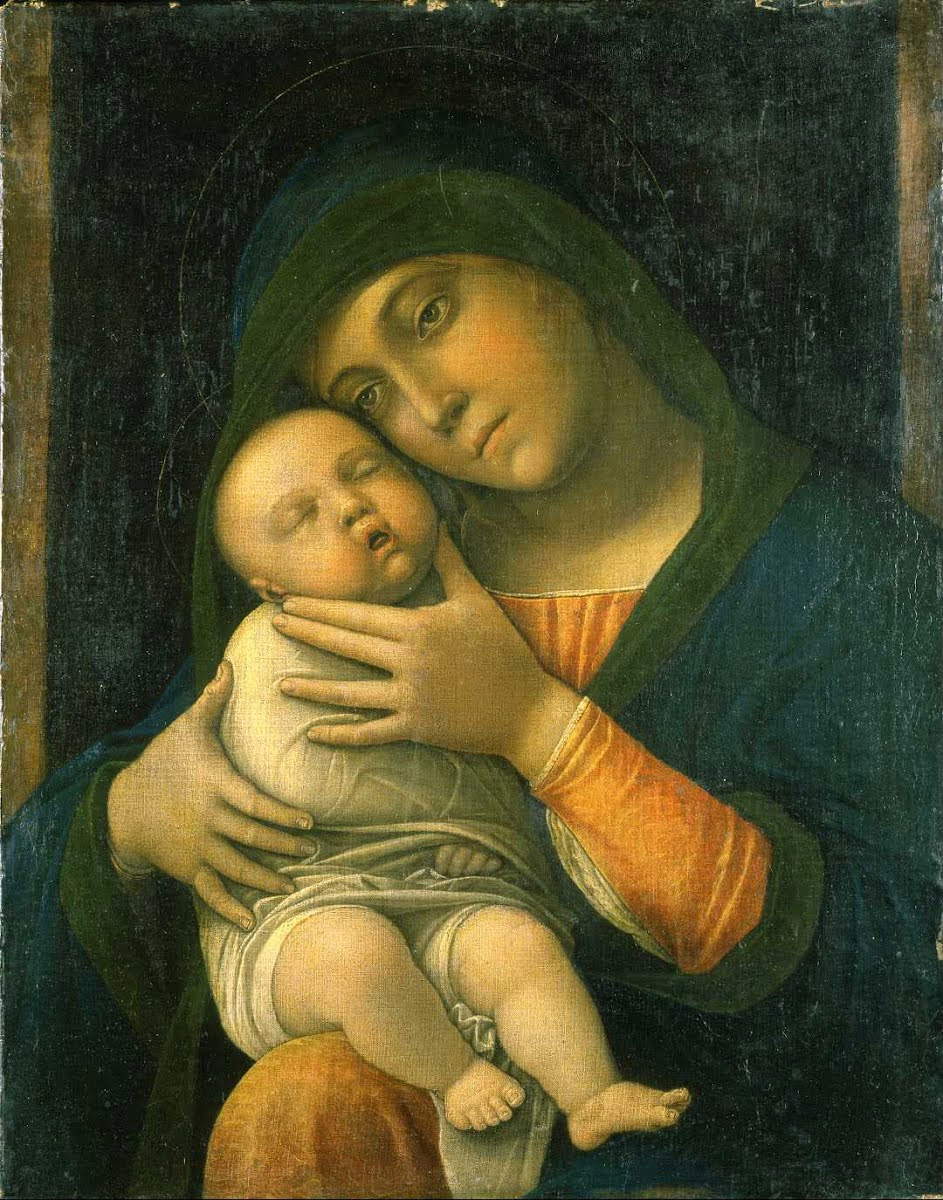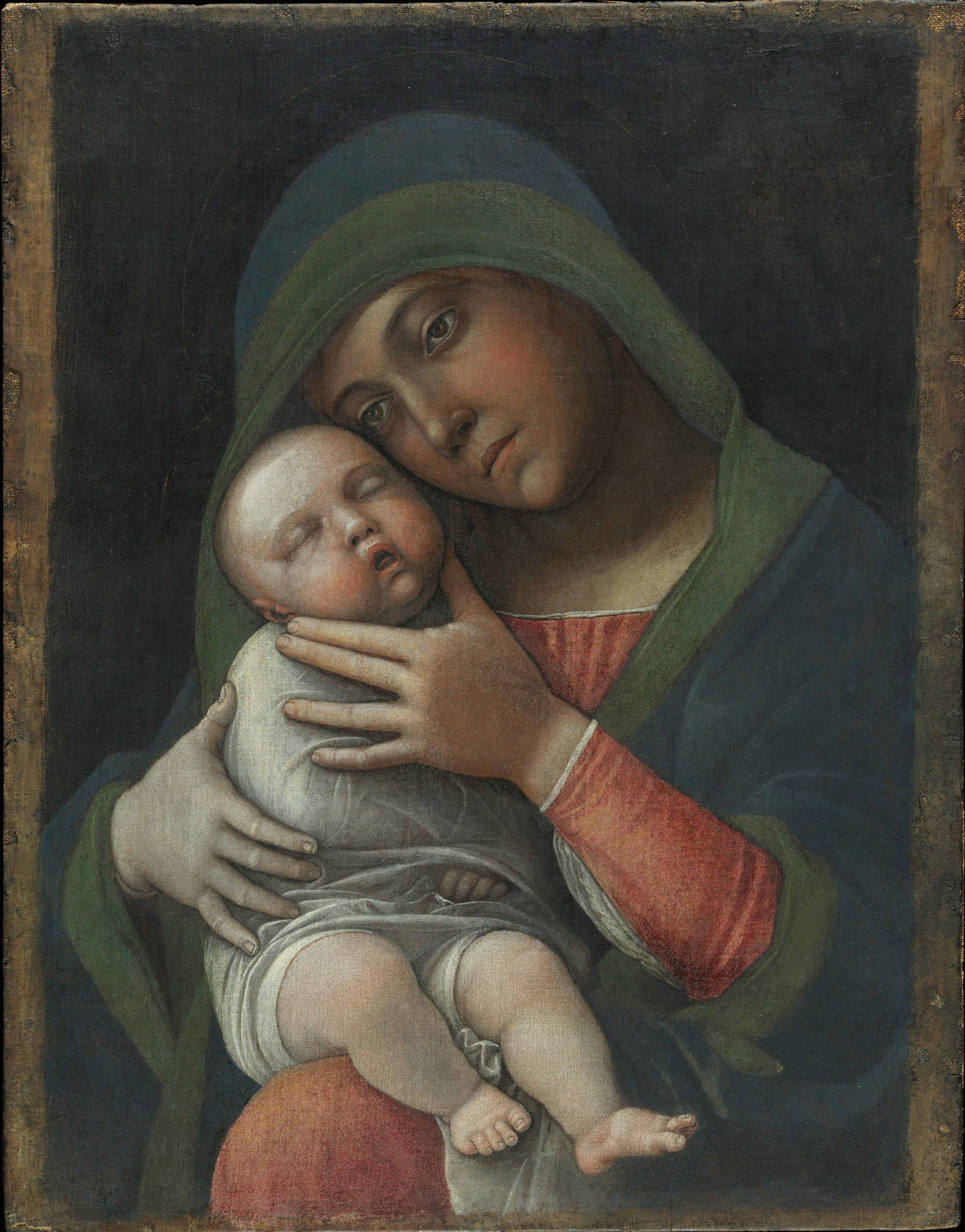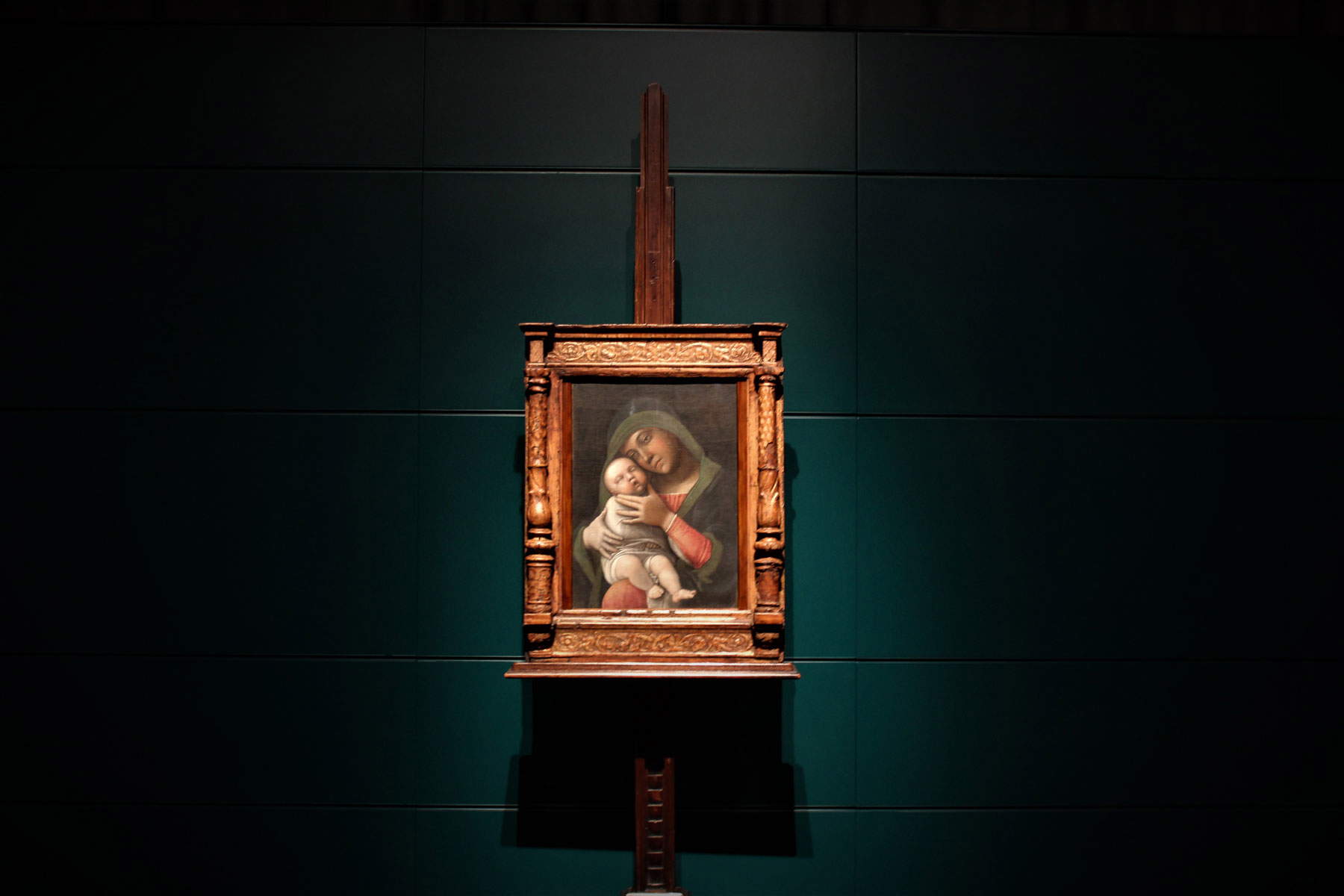A nineteenth-century restoration had altered the appearance of Andrea Mantegna ’s Madonna and Child (Isola di Carturo, 1431 Mantua, 1506) preserved at the Poldi Pezzoli Museum in Milan to such an extent that it was particularly difficult to judge: the author of the restoration was one of the greatest painters of early nineteenth-century Italy, Giuseppe Molteni (Milan, 1800 - 1867), who, however, had intervened on the work in such an invasive manner that it was impossible to tell to what period of Mantegna’s activity the painting dated. It is one of the Venetian artist’s most intimate works, part of a production intended for private devotion: the Madonna holds the Child on her knees, gently clasping him in her arms so that he does not fall, caressing him and bending her head to brush her son’s, her gaze seeming almost lost, melancholy, as if the Virgin is foreboding the Child’s fate. He, chubby, his cheeks flushed, wrapped in a white veil (another foreshadowing of his last days, since it resembles a shroud), fell asleep, open-mouthed. The sculptural volumes, the sharp, stiff folds of the drapery, and the rounded faces are unmistakable figures of Andrea Mantegna’s style.
The painting, in the nineteenth century, was part of the collection of art historian Giovanni Morelli (Verona, 1816 - Milan, 1891), among the greatest connoisseurs of his time: it was he who, to clear a gambling debt, had sold the painting in 1861, for 2,000 lire at the time (the equivalent of about 5,000 euros today), to Gian Giacomo Poldi Pezzoli (Milan, 1822 1879). Since then, the work has never left the family’s collection, and as early as 1879, the year of Gian Giacomo Poldi Pezzoli’s death, the value of the painting marked in the inventory of his possessions is set at 15,000 liras (about 62,000 euros today), following an estimate made by Giuseppe Bertini, the first director of the Poldi Pezzoli Museum.
 |
| Andrea Mantegna, Madonna and Child (1490-1499; lean tempera on canvas, 35.5 x 45.5 cm; Milan, Museo Poldi Pezzoli). Before the restoration |
Shortly after the purchase, Gian Giacomo Poldi Pezzoli had the work restored, as anticipated, by Giuseppe Molteni, who was then director of the Pinacoteca di Brera and a family friend. Molteni was not only a valid painter but was also a much sought-after restorer, because he was able to propose to his patrons complex integrative restorations that were able to improve the appearance of the ancient paintings, sometimes even altering the works in a way that would seem excessive to us today: for the time, however, it was normal and, indeed, it was a practice that followed the taste of the time and the orientations of the patrons. Thus Molteni enriched the Madonna’s robe with numerous golden highlights, repainted the blue mantle, and arbitrarily stretched Mary’s arms at the edges to give the impression that the characters were standing in front of a window, with the result of altering the setting that Mantegna had given to the composition and perspective layout of the work. Therefore, it had to be an ameliorative intervention, according to the canons of the time: that is, the ancient work had to adapt to the taste of the patrons. Finally, Molteni painted the surface, thus going to darken the original tones and also altering the color balance, especially in the gap between the background and the Virgin’s mantle, which became much less comprehensible.
Thus, in 2019, the Poldi Pezzoli planned to recover the real Mantegna, with a restoration entrusted to theOpificio delle Pietre Dure of Florence and made possible thanks to the decisive support of the Giulio and Giovanna Sacchetti Onlus Foundation. Directed by Marco Ciatti and Cecilia Frosinini, with the technical direction of Lucia Maria Bresci and the technical-scientific collaboration of Roberto Bellucci, the Opificio’s intervention was carried out by Lucia Maria Bresci with the collaboration of Ciro Castelli: first, an in-depth diagnostic campaign was carried out, which then continued accompanying each phase of the intervention. The in-depth diagnostics was also necessary to fully understand the execution technique, the conservative state of the painting, the extent of Molteni’s intervention and, finally, to clarify some small discoveries that were revealing themselves to the eyes of the restorers of the Opificio. For example, at the Virgin’s mantle, the investigations had revealed a double pictorial version: a drafting in Prussian Blue, a pigment that was very popular from the 18th century onward, characterized by a drapery of typically 19th-century taste, which was therefore due to Molteni’s retouches; a drafting still very intact in Azurite (an ancient, copper-based pigment), in which the original pictorial version could be recognized. The gilded decorations on the red robe were also due almost entirely to Molteni: in fact, the shell-gold brushstrokes possessed an excessively painterly character and followed patterns of reconstructive fantasy that had nothing to do with Mantegna’s fifteenth-century and antiquarian culture. Finally, the putty varnish, with which Molteni had wanted to protect the pictorial layers, had profoundly altered the work, making it aesthetically similar to an oil painting and thus making the peculiarities of a technique in which the very thin tempera, blending with the minute texture of the textile support, builds a characteristic morphology visible even to the naked eye, which accompanies an image with opaque but luminous tones.
For the Opificio, therefore, it was a matter of performing a very complex intervention, since the conservation situation of the Poldi Pezzoli’s Madonna and Child was complex. As far as conservation aspects were concerned, excluding the cutting of the central area, the original canvas was in good condition and adhered well to the remodeling one, so the restorers decided to keep the 19th-century lining done by Molteni, so as not to run the risk of making the restoration too invasive. “Our restoration intervention,” the Opificio explained, "was therefore directed at restoring a chromatic and formal balance, through the gradual and selective removal of the varnish. This was a real challenge, of which, in the literature, there was only one other case of partial success, carried out on the Adoration of the Magi, also by Mantegna, at the Getty Museum in Los Angeles, by Andrea Rothe, an Italian-trained restorer who recently passed away. The removal of an ancient varnish from a stratigraphy as naturally highly absorbent as that of an unprepared canvas still constitutes a remarkable confrontation for any restorer, one that cannot be tackled except by means of timely and continuous means of control; a challenge made even more complex by the need to use nonaqueous methods because of the ’thin’ and highly sensitive nature of the pictorial film."
 |
| Andrea Mantegna, Madonna and Child (1490-1499; lean tempera on canvas, 35.5 x 45.5 cm; Milan, Museo Poldi Pezzoli). After restoration |
 |
| The work at the Poldi Pezzoli Museum |
Through cleaning it had been possible to extract any residual paint from the surface, restoring the aesthetic effects sought by the artist, obscured by the varnish applied by Molteni. Following the same philological methodology of restoration, the Opificio then decided to remove the 19th-century repainting of the Virgin’s mantle and the false gold decorations of the robe. Finally, in the course of cleaning, traces of a gold inscription, partially worn away by past cleaning, were found on the dark background, reconstructed thanks to the mapping on a macro image of each gold fragment identified under the microscope. The inscription, unfortunately visible only photographically and on a reconstruction chart, corresponds to a verse from the Song of Songs, Nigra sum sed formosa (“I am black, but I am beautiful”), usually referred in ancient times to the cults of black Madonnas that were already widespread in the 15th century, even in courtly circles.
“Today, thanks to the rediscovered aesthetic harmony and, consequently, content, of the painting,” the Opificio points out, “we can better understand the artist’s almost pauperistic intent in presenting an image of motherhood, intimate and very sweet, but far from any celebratory and royal intent, almost ennobled by its very poverty. The restoration has thus allowed us to rediscover a painting different from the one we were used to appreciating, which better draws the attention of the relative to the tender intimacy of a mother and her child, who become a symbol and icon of tenderness.” Not only that: the restoration also made it possible to formulate a more precise dating for the Madonna and Child. Indeed, there were those who believed it to be a youthful work executed in the Padua years, others who instead assigned it to the beginning of the Mantua period (thus to a span of years between 1462 and 1470), and there were also those who considered it a late work. Restoration has been able to steer critics more confidently to a date in the 1490s, which can be found through comparisons with other paintings. This, then, is what a restoration is: a way to recover the work as the artist intended it to be, an activity that serves to make a painting more readable and thus to convey more information and knowledge about an author’s work.
Warning: the translation into English of the original Italian article was created using automatic tools. We undertake to review all articles, but we do not guarantee the total absence of inaccuracies in the translation due to the program. You can find the original by clicking on the ITA button. If you find any mistake,please contact us.